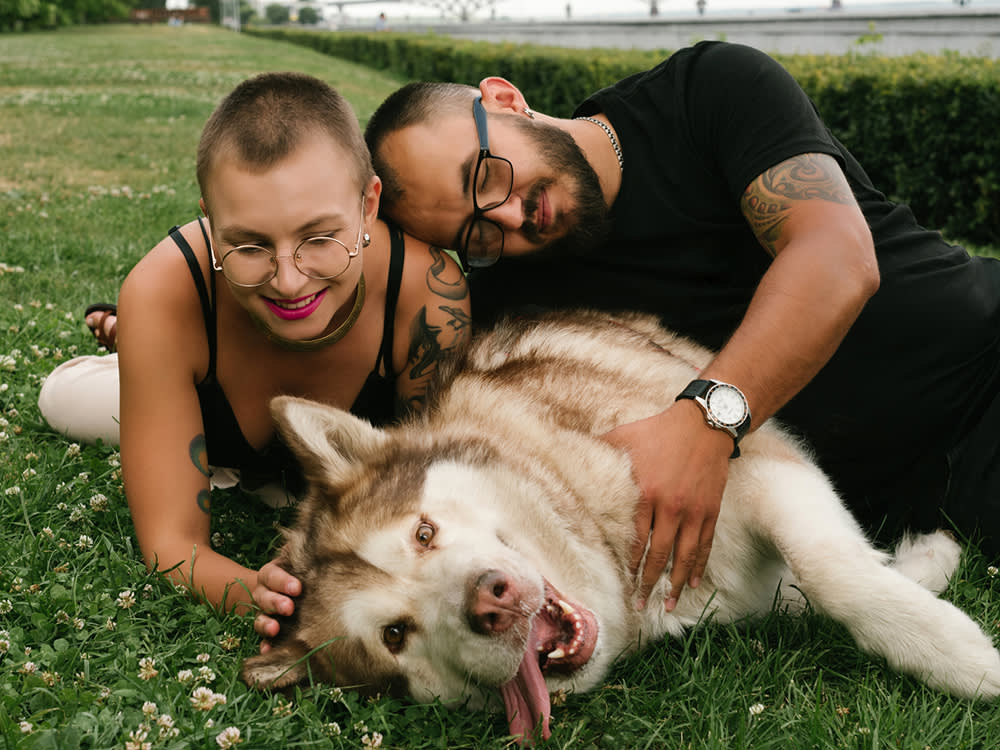How to Woo Your Way Into Your New Partner’s Pet’s Heart
Meeting your new partner’s pet is an honor — winning them over is another story. Here are some tips for being friends with your significant other's best animal pal.

share article

Your pet wants you to read our newsletter. (Then give them a treat.)
Heavy Petting is a weekly column full of relationship advice for pet parents — so you and your boo don’t end up fighting like cats and dogs over the cat and dog.
I met my dog—who is my very best friend in this world—accidentally, on the night I met my partner. I’d found out that Megan had a puppy early into our first date; and I have to say this was a very appealing personal fact. Their apartment was on my bike ride home, so I dropped them off, and then I was inept looking up biking directions to travel back across the city when — behold! — a three-month-old Finn came scrambling out of the door, tugging on his leash. I promise, I wasn’t angling for a meeting, but I was immediately enamored. Finn, meanwhile, really liked the tassels on the back of my Doc Martens.
Still, I hurried away. I remember being so happy I’d met Megan's puppy — Megan, too, obviously — but I was worried that it wasn’t the most conscientious environment. I felt unprepared, in a way. An excited, brief, squealing introduction and then I rush off on a scary bicycle contraption? Would Finn and I ever recover?
We did recover, of course; but also I’ve learned that there are thoughtful, considerate ways to introduce partners to your dogs. We did get one thing right (well, almost), according to biologist Dr. Marc Bekoffopens in a new tab, the author of the Emotional Lives of Animalsopens in a new tab, who suggests picking “a neutral area and have the dog and the human meet there and see how it goes.” Outside of Finn’s house, on a tuft of grass by the street, was maybe a little close to home, but a solid mix of familiar and neutral is best, confirms Dr. Bekoff.
Additionally, I was meeting a trusting, enthusiastic puppy. For dogs that are more shy, hesitant or for people who aren’t as accustomed to wooing canines— there are some more elemental strategies. Dr. Nathan Lents, a biology professor at John Jay College, summarizes them this way: “Play hard to get!” Not reaching towards the dog or cooing at them is a way to “let the dog set the tone. No sudden movements or loud sounds. The key thing is for everyone in the room to be calm, relaxed, and not focused on the dog at all. Act as if the dog isn’t even there.”
Then, once the dog is relaxed, you can get to the treats and treasures phase. A few weeks after I’d met Finn, I heard about my friend Greta meeting her new partner’s dog. She brought bacon in a little plastic bag in her pocket to, in her words, ”bribe my way into his heart.” That dog was obsessed with Greta, obviously. I am not above bribery, of course, but Dr. Bekoff says that he doesn’t even think Greta's method was bribery.
“I think it's a good idea, and I don't see it as a cheap trick. It can set the trend for a long-term friendly reciprocal relationship and many if not most dogs like food and toy rewards,” he says. “I don't see anything disingenuous about using them.”
Dr. Lents expands on this point. “This is not bribing for affection, but rather coaxing the dog to code the person as a non-threatening affiliate. If the pet is still timid at this stage, it may be a good idea for the new person to simply leave the toy or treat on the floor or table and let the dog approach if and when they are comfortable. Eventually, hand-feeding is a good next goal but don’t rush it,” says Dr. Lents. “Forcing this interaction before the dog is really ready can actually prolong the untrusting phase.”
Finally, Dr. Bekoff reminds that this is all super individualistic. These are some good ground rules, but just like people, dogs are all different, specific weirdos. “People sometimes get upset when there's no hard and fast answers,” he says. “But dogs are individuals and humans are individuals and so too are dog-human relationships.”

Maggie Lange
Maggie Lange is a writer, editor, and columnist. Her work has been featured in New York Magazine, Vice, Guernica, GQ, Rolling Stone, Pitchfork, Elle, and Bon Appetit. She lives in Philadelphia with her favorite brindle boy, Finn.